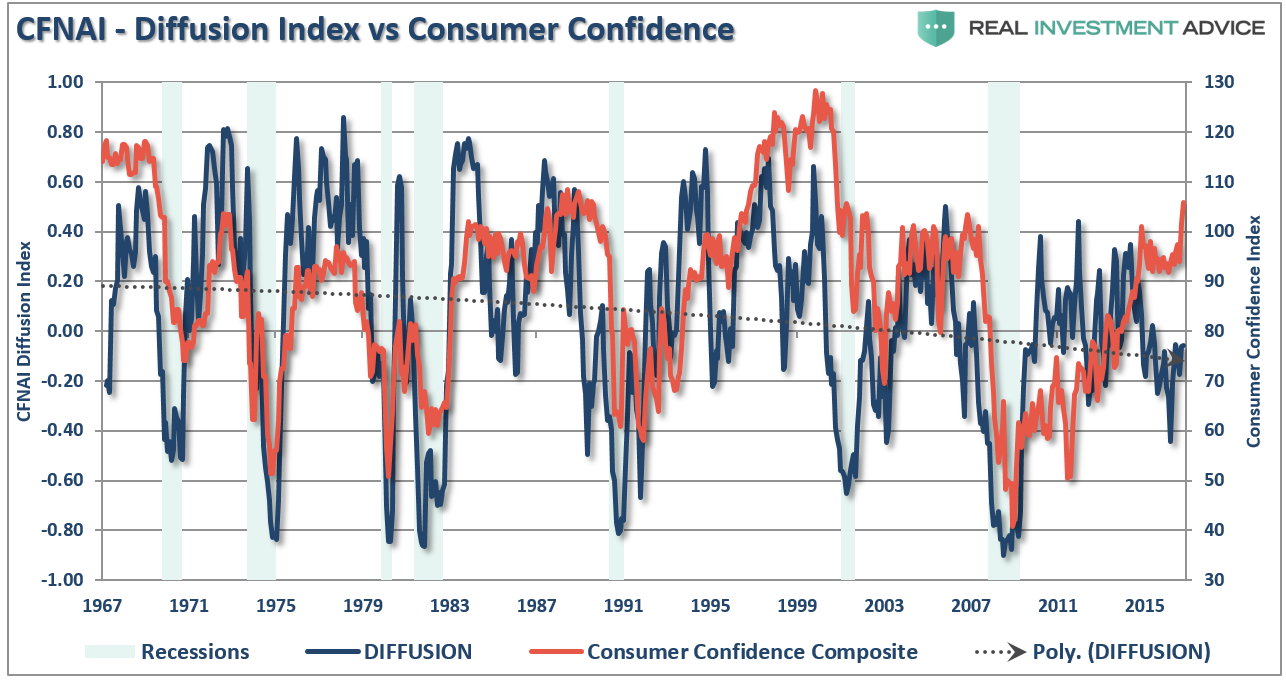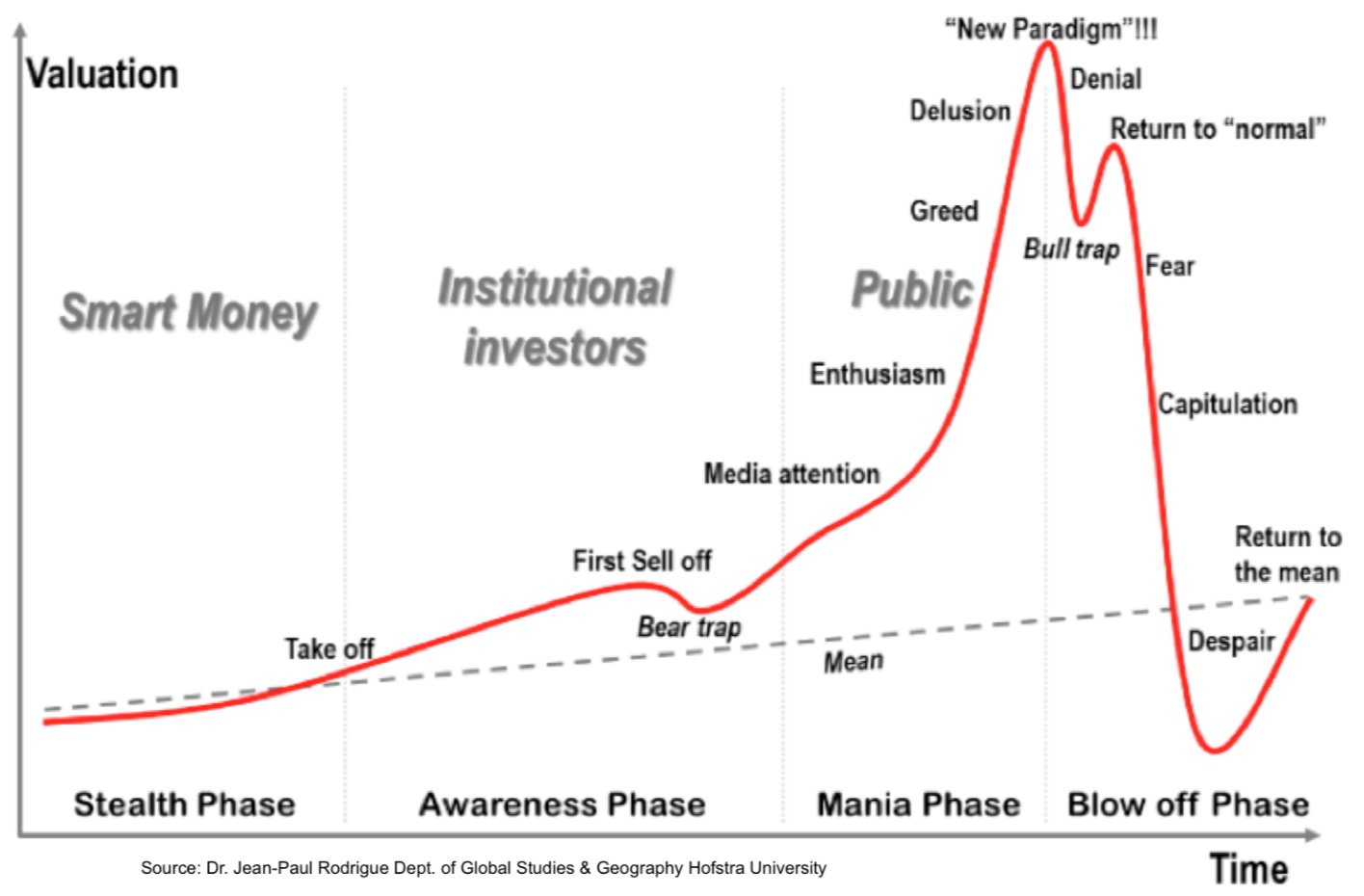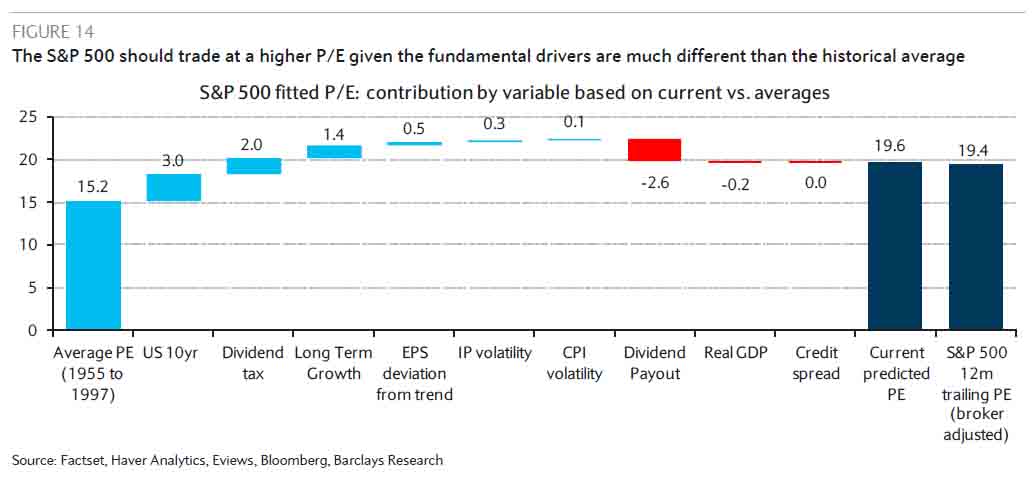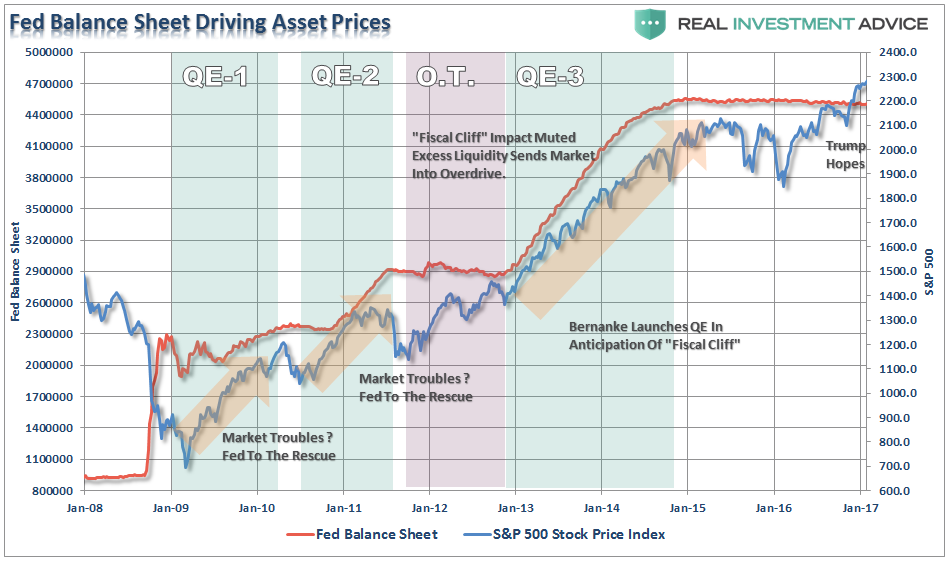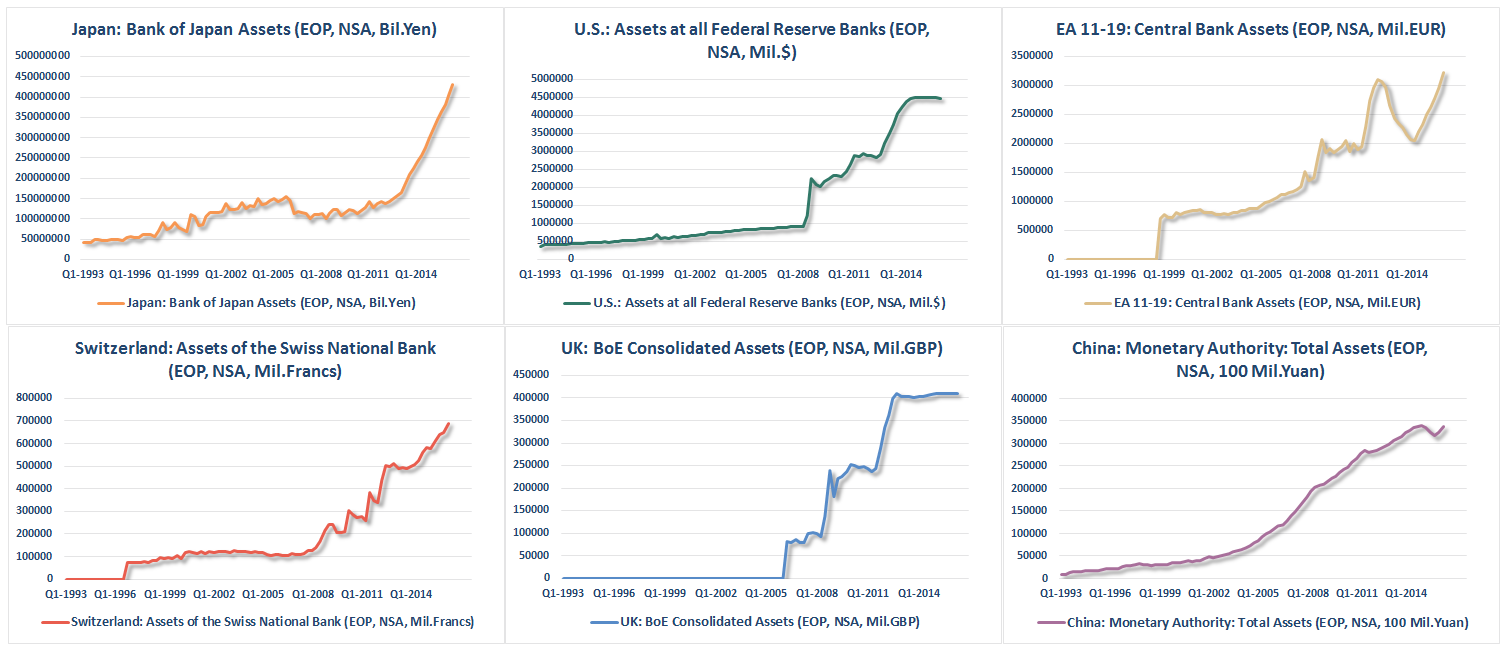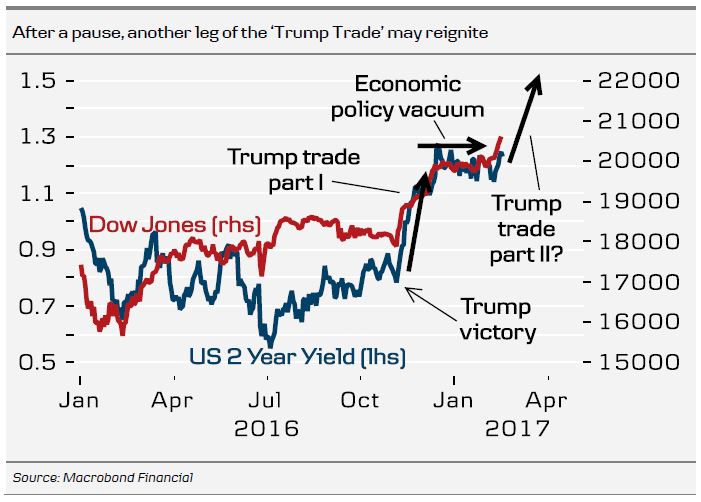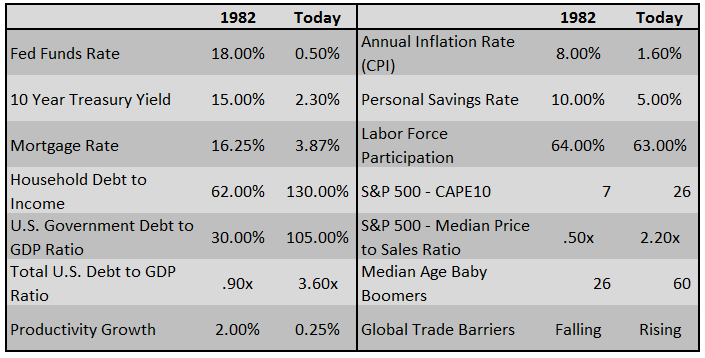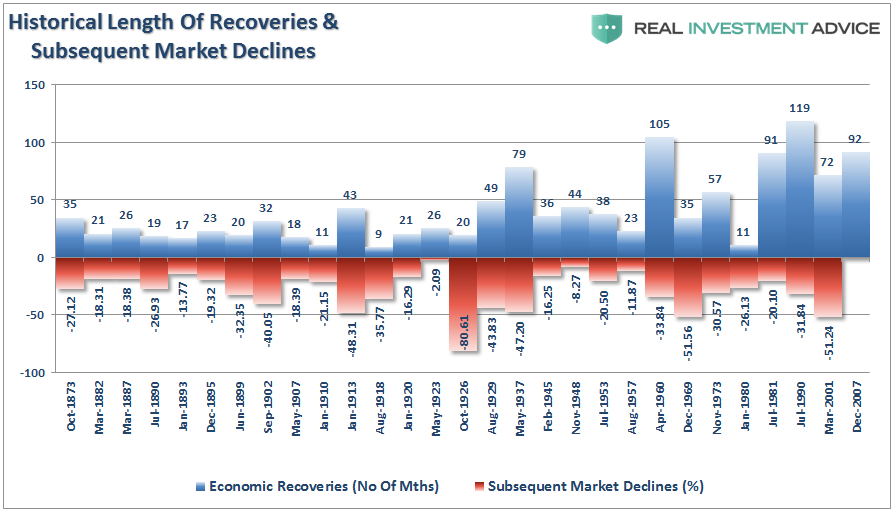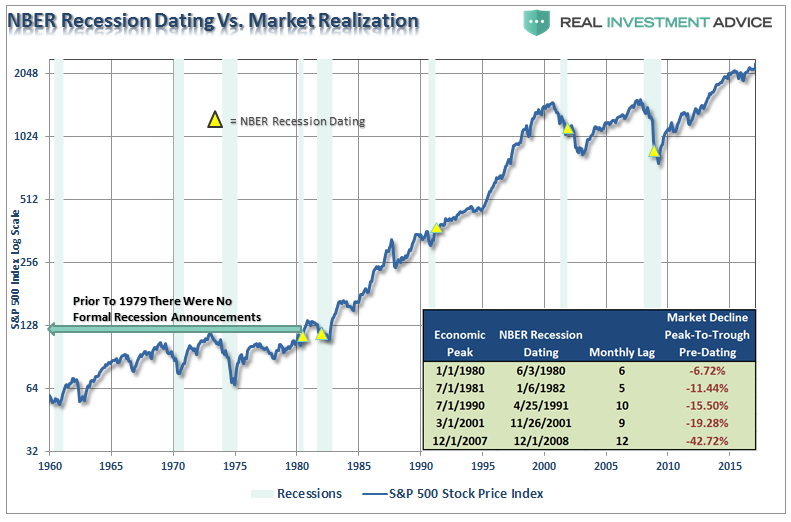by Lance Roberts, Clarity Financial
Last week Frank Chaparro penned an interesting note:
“It looks like this bull market just won’t quit. Friday marked the 2,003rd trading day since the stock market rally began back in 2009, making it even longer than the bull market that preceded the 1929 crash.
And since President Donald Trump’s surprise victory in November, stocks have been on a seemingly unstoppable upswing with the S&P 500 rallying nearly 10%.
The S&P 500, Dow Jones industrial average, and the Nasdaq all recently hit all-time highs at the same time for five straight days, making for the longest such streak in 25 years.
On top of that, stocks have not witnessed a 1% decrease since October 11. That is the longest streak since 2006.“
He’s right, this really seems to be a “can’t lose” market.
Let’s evaluate a few of the reasons given as to why you should “buy” this bull market.
Investor Confidence Is Soaring
There is little doubt that since the election both investor and consumer confidence has soared. In fact, confidence (soft data) has become extremely detached from the actual activity (hard data) within the economy.
Historically, this deviation has not lasted long, and it has always been “hope” giving up ground to the underlying “reality.” But nonetheless, it is “hope,” which is more commonly known as “animal spirits,” which drives markets higher in late stage market advances. Which suggests this is as good of a time as any to remind you of the following chart of investor psychology.
So, if you want to “buy” this bull market currently, you just need to figure out where in the current cycle you are.
Maybe this will help. Barclay’s just “goal sought” an entire analysis to justify 20x earnings as a “fair valuation” in the market. Does “New Paradigm” stage seem fitting?
“And that, ladies and gentlemen is how sell side analysts use ‘animal spirits’ to explain that a market which is valued 33% higher than historical average, is really ‘fairly valued.'”
Central Banks Continue Their Support
The economic recovery has been weak. In fact, we are currently running the slowest average annual growth rate in the history of the U.S. But, given a weak gross domestic product (GDP), the lowest rate of home ownership since the 70’s and a large segment of the workforce no longer counted, the S&P should not have moved from its recent its low of just over 600 to its current record levels. Right?
Of course, it is widely understood by now the reason the market has risen well in excess of the underlying economic activity is summed up with just two words: Quantitative Easing.
Of course, it isn’t just the Fed engaged in injecting liquidity into the financial markets, but every major global Central Bank as well.
Without the interventions by the Central Banks, it is not only very likely that the current market would be much lower in price, but it is extremely likely that the U.S. would have already experienced a secondary recession. As long as Central Banks continue to expand their balance sheets, the bull market has an ongoing support particularly as countries, like Japan, are directly engaged in buying more of the equity market directly.
This could very well inflate markets even further. I can’t argue that point.
However, there is a finite limit to the ability of Central Banks to absorb the debt and equity markets. Where that limit is; who knows. But there is a cold reality that when the limit is eventually reached the unwinding of the Central Bank liquidity bubble will likely not be kind.
Trumponomics Is The Cure For What Ills
Just recently Barbara Kollmeyer penned a piece for MarketWatch on how the “Trump Rally” could reignite for stocks. To wit:
“…analysts at Danske Bank have already started mapping out how the rally inspired by the election of President Donald Trump last autumn might be reignited…with signs that Trump and his administration seem ready to push forward with an agenda of economic reforms.“
This analysis, of course, is all based on the assumption of the passage of fiscal policy by the Trump administration with NO OFFSETS. In other words, the entire premise is based upon the optimal outcome each policy enacted such as:
- Tax reductions WITHOUT a border tax
- Healthcare repeal without an offsetting unintended consequence
- Zero impact from the tightening of monetary policy by the Fed
- No offset from the continued strength of the US dollar
- No offset from increasing levels of debt and an expanding deficit
- No expectation of political infighting from a highly divisive Congress and Senate.
- Etc.
As my partner Michael Lebowitz recently penned:
“Many investors are suddenly comparing Trump’s economic policy proposals to those of Ronald Reagan. For those that deem this bullish, we remind you that the economic environment and potential growth of 1982 was vastly different than it is today. Consider the following table:”
“The bottom line is that one should respect the narrative and its ability to propel the market higher. However, think for yourself and truly understand the pros and cons of Trumps proposals as well as the daunting odds of enacting them. Your investing success is dependent on determining whether the narrative is the truth or simply a rationalization to provide comfort and control when desperately needed.”
The reality is there are a lot of things that can go wrong along the way from both fiscal and monetary policy mistakes. Assuming, a “no risk” fiscal policy platform under the Trump administration will likely prove dangerous to investors in the not so distant future.
This Is No Alternative (T.I.N.A.)
Bond yields are low. Cash yields are even lower. Therefore, the only place for investors to get a return on their “cash” is in equities. In fact, because of Central Banks, as noted above, investing in equities is now just as “safe” as money markets because they will never let the markets crash.
Seems completely logical. Particularly when you are investing your “hard earned money” into the highest risk investments presently available.
What could possibly go wrong?
The Market Is Cheap Based On Forward Earnings Estimates
This is a strong argument. Wall Street analysts currently have earnings estimates surging over the next couple of years in particular due to the potential tax cuts as discussed above. As earnings recover, it is hoped the markets will move from a “valuation based expansion” to an “earnings based expansion.”
There are three problems that investors should consider in respect to this analysis:
- Estimates are generally overstated by as much as 33% historically. (shown in the chart below.)
- There are no considerations given to the impact of offsets from other policies such as border taxes, costs, regulatory requirements, fiscal or other monetary policies which could negate some of the positive impacts of lower tax rates.
- The current ramp up in estimates are based on the assumption that corporates rates will fall from 35% to 15-20%. There is no consideration given to effective tax rates currently averaging 12%.
Forward earnings, as stated above, is an extremely poor indicator of future performance. However, the fact the forward earnings forecasts have continued to fall, so that companies can “beat” their respective earnings estimates, shows the fault in using “guesses” about future profitability in trying to justify owning overvalued assets in the first place.
But furthermore, even based on forward estimates for 2018, the markets remain expensive.
There Is No Recession In Sight
“There will eventually be a recession, there is just not one anywhere on the horizon currently.”
Saying that there will not be a recession is just naive and very short sighted. Recessions are part of the economic cycle and are inevitable. Considering that we are already more than 8-years into the current economic recovery, and in the 3rd longest economic expansion in history, we are likely closer to the next recession than not.
Of course, the real problem is that the media, Wall Street and the majority of the blogosphere never sees the recession until after the fact for one simple reason, the data they are working off of is subject to massive negative revisions in the future. This is why even the National Bureau of Economic Research, the agency responsible for dating recessions, is always late to the call.
As far as the stock market goes – the average drawdown during a recession has been in excess of 30%. Ignoring this reality is perilous to your long-term returns.
Conclusion – The Hope For A “Greater Fool”
The “Greater Fool Theory” surmises there is always a “greater fool” than you in the market to sell to.
For Wall Street, that greater fool is you. Haven’t you ever wondered why Wall Street never tells you to “sell and raise some cash?”
Of course, this leads to the belief there will always be someone to “sell to” when things get ugly. While the answer is “yes,” as there is always a buyer for every seller, the question is always “at what price.”
Then there is the issue, as discussed last week, about the flaws of our own psychology. You may believe that you will sell out in time to avoid major financial disaster, history suggests you won’t.
Here is the reality, the market will eventually mean revert because it always does. This is the most powerful argument for a huge correction. No matter how powerful a rally, the market will not go up forever. While that observation is obvious, it does not prevent it from being any less true.
The eventual reversion is part of the market cycle. This is why managing portfolio risk is so critically important and why if you don’t sell high, you cannot buy low.
“Being bullish on the market in the short term is fine – you should be. The expansion of Central Banks balance sheets and the hopes of a fiscal policy tsunami should continue to support stocks as long as no other crisis presents itself. However, the problem is that a crisis, which is ALWAYS unexpected, inevitably will trigger a reversion back to the fundamentals.”
With margin debt at historically high levels, it is when the “herd” begins to turn that is the problem. It will not be a slow and methodical process but rather a stampede with little regard to valuation or fundamental measures. As prices decline it will trigger margin calls which will induce more indiscriminate selling. The vicious cycle will repeat until margin levels are cleared and selling is exhausted.
The reality is that the stock market is extremely vulnerable to a sharp correction. Currently, with complacency and optimism near record levels, no one sees a severe market retracement as a possibility. The common belief is there is “no bubble” in assets and the Federal Reserve has everything under control.
Take a moment to compare what you have heard, and read, with the questions presented here. Draw your own conclusions and invest appropriately.
Lance Roberts
Lance Roberts is a Chief Portfolio Strategist/Economist for Clarity Financial. He is also the host of “The Lance Roberts Show” and Chief Editor of the “Real Investment Advice” website and author of “Real Investment Daily” blog and “Real Investment Report“. Follow Lance on Facebook, Twitter and Linked-In
Copyright © Clarity Financial






